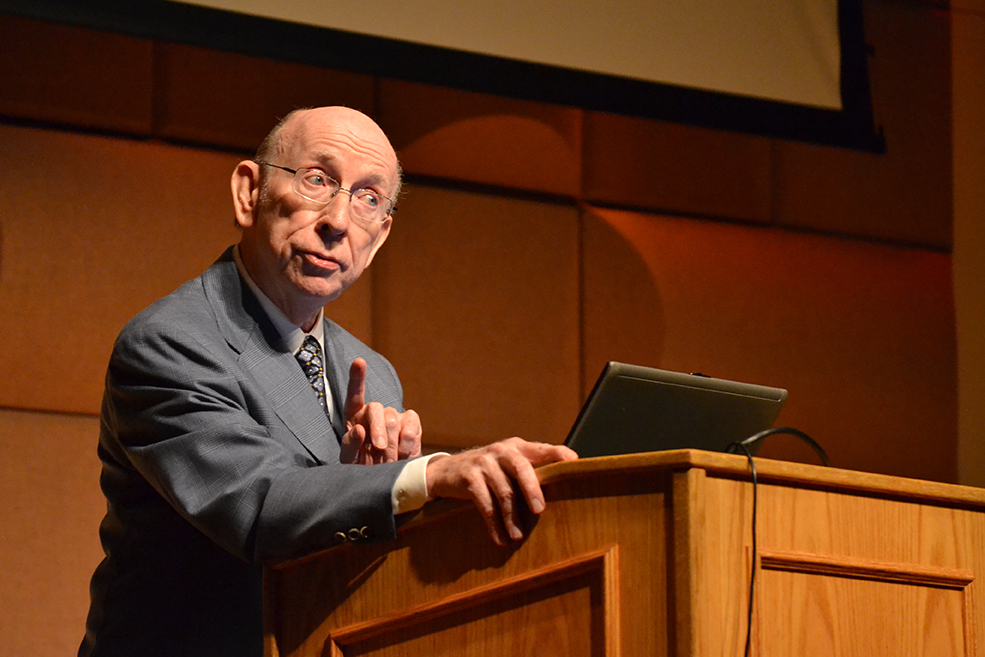When you listen to music, do the melodies dance in your head as the highs and lows of each tune echo through your soul? When you look at art, do the images come to life guided by the vibrancy of the specific colors chosen by the artist? Perhaps you study each composition, allowing your left-brain logic to question, “Why?”
If you’re the type to ask these questions, then you belong in the audience of Professor Emeritus Frank Cooper’s Musicology Lecture Series.
In his third presentation held Sept. 29 in the Clarke Recital Hall, Cooper analyzed the relationship between composers and artists to their patrons and commissions. He offered a vast number of examples like the first noted music lesson payment dated 1,900 B.C. on a cuneiform tablet, the role of the medieval church in the arts and the recent compositions of John Williams.
By the end of the presentation, Cooper revealed why patrons are so important to not only the careers of each artist and composer discussed, but also to private and public institutional agendas. Some of these reasons included the musical expression of the Christian faith, political propaganda and contributions to the future of art and music.
Religion and church were some of the biggest reasons for the creation of music and art throughout human history, Cooper said.
“Individuality was suppressed among monastery residents so we know almost no composers’ names associated with church music before the ninth century. The church, however, was the ultimate patron,” Cooper said.
During medieval times, many churches employed talented creators to build using a Gothic style and paint images on the walls and ceilings depicting biblical scenes and the nobility. Throughout Europe, illuminated manuscripts also grew increasingly famous as works of art and books of religious texts.
Cooper also discussed how the secular world began to accept the arts as aristocracies emerged.
“The newer liege lords could enjoy the luxuries of professional entertainment,” Cooper said. Because they were wealthier, they’d employ minstrels to organize and perform plays at lavish celebrations and would even hire them for permanent employment at their homes.
As a more recent example, Cooper discussed composer John Williams’ work, whose credits include the scores to films “Jaws,” “Jurassic Park” and “E.T.”
Cooper played a video of the Star Galaxy Orchestra performing the widely recognized “Imperial March” from “Star Wars” to his audience. Immediately, the guests recognized the tune, revealing the significance of Williams’ career in film music. Stormtroopers and Darth Vader paraded across the stage, earning a chuckle from the crowd.
Cooper’s Musicology Lecture Series is a hit with students, UM alumni and Miami locals.
“We’ve been coming to his series for many years and we think that Cooper is an absolute treasure. His ability to weave together different strings to tell an incredible story is unique,” said Cosme Gomez, a UM alumnus.
“Very few people can take history, art and music and integrate it, no matter what era. He is amazing,” said Rosina Pellerano-Gomez, a UM alumna and Iron Arrow member.
For those who have yet to attend one of Cooper’s lectures in the series, his fourth and final lecture, “Similarities, Cross-Currents, & Analogies Among the Arts” will be held 7:30 p.m. on Thursday, Oct. 13.
The event is held at the Weeks Center for Recording and Performance in the Clarke Recital Hall. Admission is $40 or free for UM students with a valid Cane Card, subject to availability an hour before the event.
For more information, visit the Frost School of Music’s events page on music.miami.edu.







